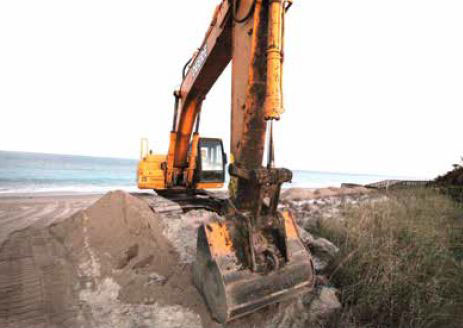
INDIAN RIVER COUNTY — Indian River County employees with clipboards will be combing three popular beaches later this month, not for sea turtles or for trash, but for tourists in an attempt to keep millions of dollars for beach sand flowing.
The latest blow to Indian River County’s efforts to shore up its beaches came last week as officials were told the county had been downgraded significantly in state rankings for funding.
This means that county taxpayers would get stuck with the tab for $6.7 million spent from 2010-12 on what is referred to as the Sector 3 project that added 560,000 cubic yards of sand to beaches from Windsor to John’s Island.
That project cost more than $15 million, with the $6.7 million reportedly “eligible for reimbursement” from the state.
“Eligible” being the key word, as the county has applied each year and been sent away empty handed.
Indian River County fell in ranking from 16th to 22nd this year.
Funds allocated each year are limited and projects are ranked by importance.
Money is doled out to top-ranked projects and when it runs out, it runs out.
Currently $25 million is allocated for the 59 projects that have applied for $88 million.
“Although the Department has acknowledged that the Sector 3 project is eligible for reimbursement of 50 percent of the project design, construction, and monitoring expenses, the County continues to rank lower than other local governments requesting state funding,” said County Coastal Engineer James Gray. “Unfortunately, nothing has changed in 2014 and we continue to be just out of the money.”
“For Indian River County to be reimbursed in FY 2014-15, the state must allocate approximately $39 million, or $14 million above the $25 million recommended to the legislature” Gray said last week.
The Sector 3 project ranked 22nd out of 59 potential projects seeking funding. Last year, the Sector 3 project ranked 16th out of 69.
The latest project, set to go out for bid in March with construction slated for November, will repair damage from Hurricane Sandy at an estimated cost of $5.4 million of which the state has promised to reimburse half.
As state dollars to fund beach replenishment get scarcer and the public becomes increasingly skeptical about spending tens of millions of dollars to pump or truck sand onto the beaches, survey data might help galvanize commissioners’ votes in favor of funding for beach projects.
As part of its multi-phase $199,000 Beach Preservation Plan, the county’s public works department is trying to quantify the recreational and economic impact of the people drawn to the area by its beaches.
To do that, poll takers will be walking the shores of Golden Sands Park and Wabasso Beach on the north barrier island and South Beach Park in Vero.
Responses will be compiled and used to give the county a glimpse into how having attractive, well-maintained beaches benefits the entire whole community.
Based on extensive studies, Florida Atlantic University economics professor William Stronge reported that Florida’s beaches added nearly $50 billion to the state’s economy in 2012.
The report also said 450,000 jobs were created statewide in 2012 by beach tourism, nearly twice the jobs created at the bottom of the 2009 recession.
“Total spending per person per day was $101.13 for out-of-county visitors and $113.15 for out-of-state visitors. Out-of-state visitors spend more per person per day because they have higher incomes than Floridians,” Stronge’s report states, drilling down specifically into data for visitors to Palm Beach County, which would be similar to Vero’s tourists.
According to Stronge’s report, the state invested $20 million in beaches in 2012 and reaped $36.76 in benefits for every dollar invested – hence the reason why the county’s coastal engineering staff is conducting the survey locally.
The two-page survey contains 15 questions, eight of which apply even to locals and seven of which are targeted toward visitors.
Though the questions have not been finalized, a draft provided by Gray lists the following questions:
- Number of people with you at the beach today?
- Total expected length of time at the beach today?
- What is the primary reason for your beach visit today?
- Do you live in Indian River County? (if so, are you here for at least six months of the year?)
- If not, where (else) do you live?
- If using the beach involved a cost, what would you be willing to pay for a day’s use?(This is not going to be used for initiating beach usage fees!)
- How much did you spend on your beach visit today? (Gas, food, lodging, other)
- Please tell us about yourself (age and occupation).
- What is the primary purpose of your visit to Indian River County?
- What is the expected length of your stay in Indian River County?
- What is the size of your traveling party?
- How often will you visit Indian River County beaches during your stay?
- Could you tell us about your expenditures while staying in Indian River County? (lodging, dining out, food/groceries, recreation, shopping, gas/car rental, other)
- How did you travel to Florida? (auto, air, other)
- Are you making overnight trips to other parts of Florida during your visit? If so, where and for how long?
The county could have hired a consulting firm to conduct the survey, but Gray said, “in an effort to save money, county staff will be conducting the week long surveys – I’m trying to balance schedules, etc.”
Gray said he has not yet set the days and times that survey takers will be on the beach, but that the survey will be conducted this month.
Survey takers will wear their Indian River County badges for identification, so those giving their personal information can check to make sure they are legitimate before participating.



